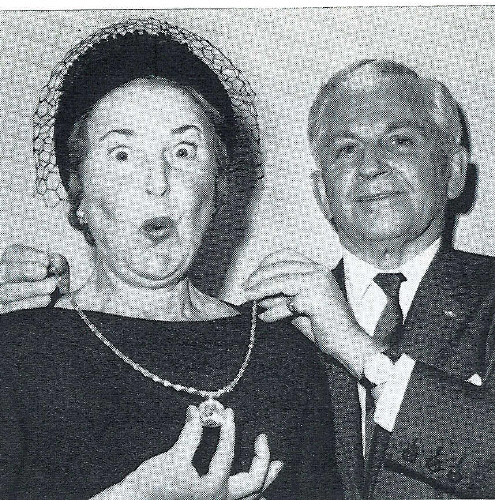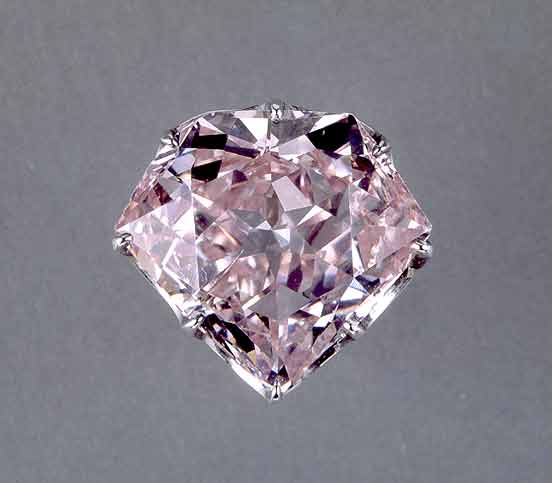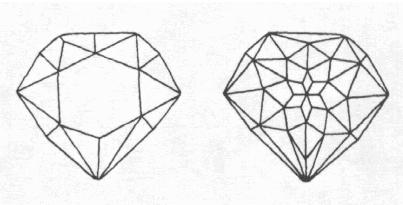The Idol's Eye Diamond
Origin of name

Idol's Eye Diamond
The name Idol's Eye seems to indicate the origin of the diamond, which is believed to have been stolen from the eye of a Hindu idol belonging to a sacred Hindu temple in India. Other diamonds which were believed to have had similar origins were the Orlov and the Hope diamonds. The latter diamond particularly became not only famous but also notorious as it was believed that a curse was placed on the diamond by the priests of the Hindu Temple, from where the diamond was stolen.
History

The Idol's eye is either a 16th or 17th century diamond. The Kollur Mines near Golconda were discovered in the mid 16th century, and had peak production outputs in the mid 17th century, when over 20 mines employing around 60,000 people were being worked.
The Idol's Eye Diamond as the name indicates seems to have had an infamous beginning, being stolen from the eye of the statute of a Hindu deity in India, like the Hope diamond and the Orlov diamond. But, fortunately no curse had been placed on this diamond, like the Hope diamond. Yet the history of this diamond is no less exciting than that of the notorious Hope diamond.
The shape of the diamond, could appropriately fit the eye of an idol, and compares favorably with other diamonds deemed to have been set in this manner, giving credence to the story that the diamond may possibly have originated from the eye of an idol.
Nothing is known about the history of the journey of the diamond from India to the West, and the first authenticated fact about the history of the diamond is, that it was put up for sale on July 14th 1865, at a Christie's auction in London. The stone was described as a "splendid large diamond, known as the Idol's Eye, set round with 18 smaller brilliants and a framework of small brilliants.' The successful bidder at this auction was an unknown buyer, just referred to as "B.B."
However there are many interesting legends associated with the early history of the Idol's Eye diamond. According to one such legend the Idol's eye was given as a ransom for Princess Rasheedah, by the Sheik of Kashmir, to the Sultan of Turkey, who had abducted her. Another legend says that the Idol's Eye was seized from the Persian Prince Rahab, in the early 17th century by the East India Company, as compensation for debts owed by him to the company. But the history of Persia does not record the existence of such a prince and the East India Company was created much later than the said period of time. The most incredible account of the origin of the Idol's Eye , was that the diamond was set in the eye of an idol at a temple in Benghazi, Libya. This is preposterous, as Libya had converted to the Islamic faith in he 8th century A.D. and idol worship had been abolished in that country ever since.
After the first appearance of the diamond and it's sale on July 14th , 1865, we next hear of the diamond, as part of the collection of jewels, belonging to Sultan Abdul Hamid II (1876-1909), of Turkey, the 34th Sultan of the Ottoman Empire.
Sultan Abdul Hamid II, ascended the throne on August 31st, 1876. He dismissed parliament in 1877 and suspended the constitution in 1878, and imposed autocratic rule on Turkey for the next 33 years. Abdul Hamid adopted a policy of pan-Islamism to get the support of other Muslim nations, against the Western Powers. During his long period of autocratic rule, Abdul Hamid II, was assisted by a nationwide secret police network, and an army, that was fiercely loyal to him, and the imposition of severe press censorship.
However discontent with Abdul Hamid's despotic rule and resentment against European intervention in the Balkans, led to the military revolution of 1908, organized by a group of disgruntled military officers belonging to the 3rd Army Corps, based in Macedonia, calling themselves as the Young Turks, and on April 24, 1909 a force from Macedonia known as the Action Army led by Mahmud Sevket Pasha, marched on Istanbul and occupied the city. Abdul Hamid was deposed and his brother was proclaimed Sultan as Mehmed V. Abdul Hamid lived in exile in Salonika in Northern Greece after his deposition in 1909. Later he came to Istanbul, where he died in 1918.
The experienced ruler and manipulator that he had been, Abdul Hamid, was intelligent enough to predict the dramatic political changes that were about to take place in his Kingdom, and accordingly made provisions for his future enforced retirement. He dispatched most of his valuable jewels to Paris, through a trusted agent, which included the Hope diamond and the Idol's Eye. The jewels were probably sold to the Paris based gem dealer Salomon Habib, but the proceeds of the sale never reached the deposed Sultan. Instead they were seized by Abdul Hamid's successors in the Government.
The Idol's Eye together with several other large diamonds belonging to Salomon Habib was put up for auction in Paris, on June 24th 1909. A Spanish nobleman seems to have purchased the diamond, which was later kept in a bank vault in London for several years.
The next time the Idol's Eye re-surfaced was immediately after World War II, when it was acquired by a Dutch diamond dealer, who sold it in 1946 to the New York diamond dealer Harry Winston. One year after this in 1947, Harry Winston successfully negotiated the sale of the diamond to Mrs. May Bonfils Stanton, daughter of Frederick Gilmer Bonfils, the publisher and co-founder of the Denver Post in 1895, a crusading newspaper that exposed crime and corruption in the United States. Mrs. May Bonfils who was once renowned for her exceptional beauty, eventually became a legendary figure in American life. She was a distinguished philanthropist and supported many worthy causes and charities in the United States, and particularly in her native state of Colorado. Mrs. May had displayed a keen interest in jewels and jewelry since early childhood and initiated a collection of these items which in her later life became one of the most famous collections of jewelry, that included the Idol's Eye, the Liberator diamond, and a unique diamond necklace that was once owned by the Maharajah of Indore, that was studded with twelve emeralds weighing 107 carats. Mrs. May Bonfils lived in isolation in a luxurious, palatial mansion, built in the 18th century architectural style of the Petit Trianon, situated within the palace complex at Versailles, France, that was meant to be private residences for the royal family and special guests. It was reported that she wore a diamond necklace with the Idol's Eye set as a pendant to it, every morning, when she appeared for her solitary breakfast. The diamond necklace consisted of 41 round brilliants with a total weight of 22.50 carats, and 45 diamond baguettes weighing approximately 12 carats. When she died in March 1962, in her eighties, her famous collection of jewelry was auctioned by Park-Bernet Galleries Inc. of New York, in November of the same year. The proceeds of this auction were distributed among various charities , in accordance with directions, specified in her last will.
the Idol's Eye was purchased at this auction by the Chicago Jeweler Harry Levinson for a sum of $ 375,000, which he presented to his wife Marilyn. The diamond was then taken to Johannesburg, South Africa, in 1967, by the De Beers Company, to be displayed at an exhibition held at the diamond pavilion. Subsequently the diamond was put up for sale at an auction in New York, by Levinson, with a reserve value of $ 1.10 million being placed on it, but had to be withdrawn from the sale, when the maximum bid fell far short of this value. Again the diamond was displayed at the Metropolitan Museum of Art in New York in connection with the 50th anniversary celebrations of Harry Winston Inc. Eventually in 1979, Mr. Harry Winston was able to dispose of the Idol's Eye to Mr. Laurence Graff, the head of the world renowned Graff Diamonds of London, in a privately negotiated deal.
Characteristics of the diamond

The Idol's Eye diamond is a 70.21-carat, colorless diamond with a slightly bluish tinge, characteristic of diamonds originating from the Golconda Mines in Southern India. The cut of the diamond is somewhere between an old-mine cut and a triangular brilliant.
Last transaction and present owners of the diamond
In January 1983, Mr. Laurence Graff was able to put together a lucrative deal that saw the disposal of three famous diamonds, the 70.21-carat Idol's Eye, the 41.94-carat Emperor Maximilian, and the 70.54-carat Sultan Abdul Hamid II, to the same anonymous buyer, for an undisclosed sum, considered to be one of the highly priced diamond transactions ever known. The Idol's Eye is still believed to be owned by this anonymous buyer.



